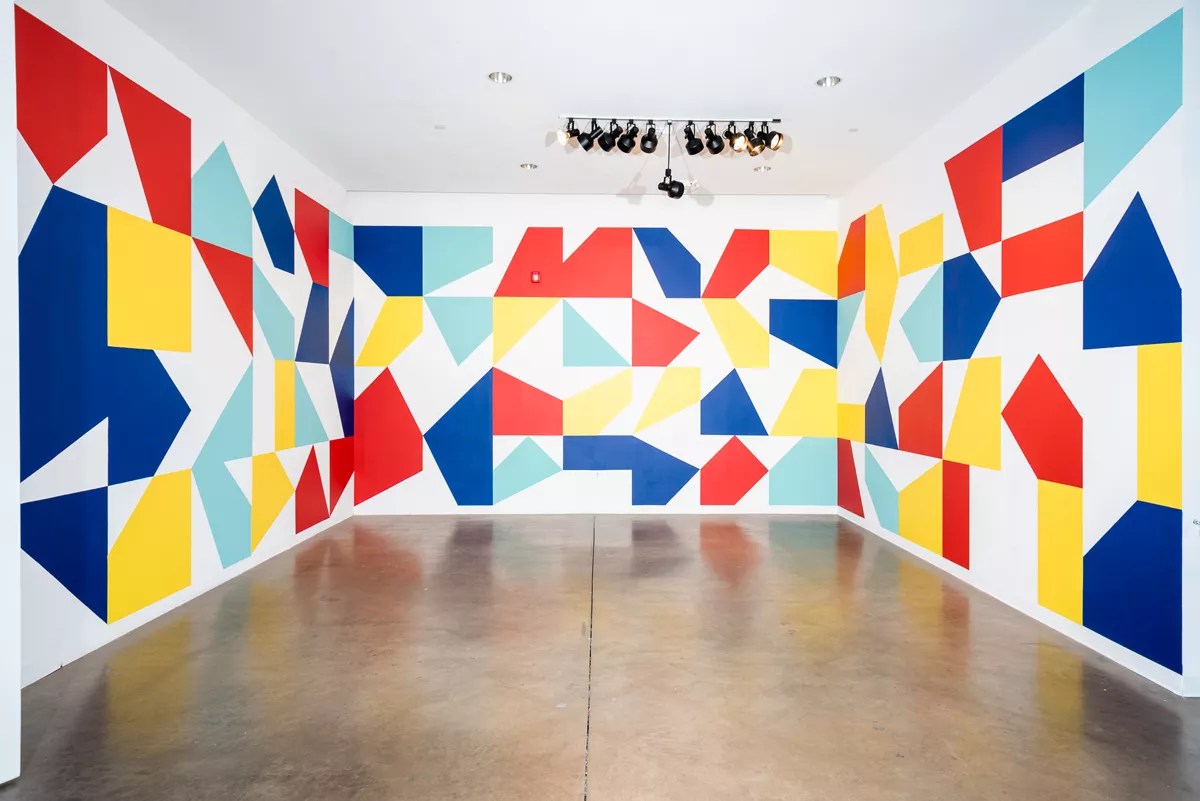
Coburn Huff

Audio By Carbonatix
There’s an unbelievably ambitious exhibition with an unbelievably short run at RedLine right now: Downshifting, which was curated by Ramón Bonilla, a RedLine resident. Bonilla was interested in highlighting the international trend of reductive art, which is art that employs some kind of less-is-more approach, thus explaining the show’s title. Downshifting is full of site-specific wall paintings and a range of smaller pieces by thirteen artists, including some from Denver and some from other countries, along with Bonilla himself. These artists are represented here by everything from the expected post-minimalism and geometric pattern painting to works with more organic sources of inspiration. “Heliocentric Distance (Cerca),” Ramon Bonilla, acrylic latex. Coburn Huff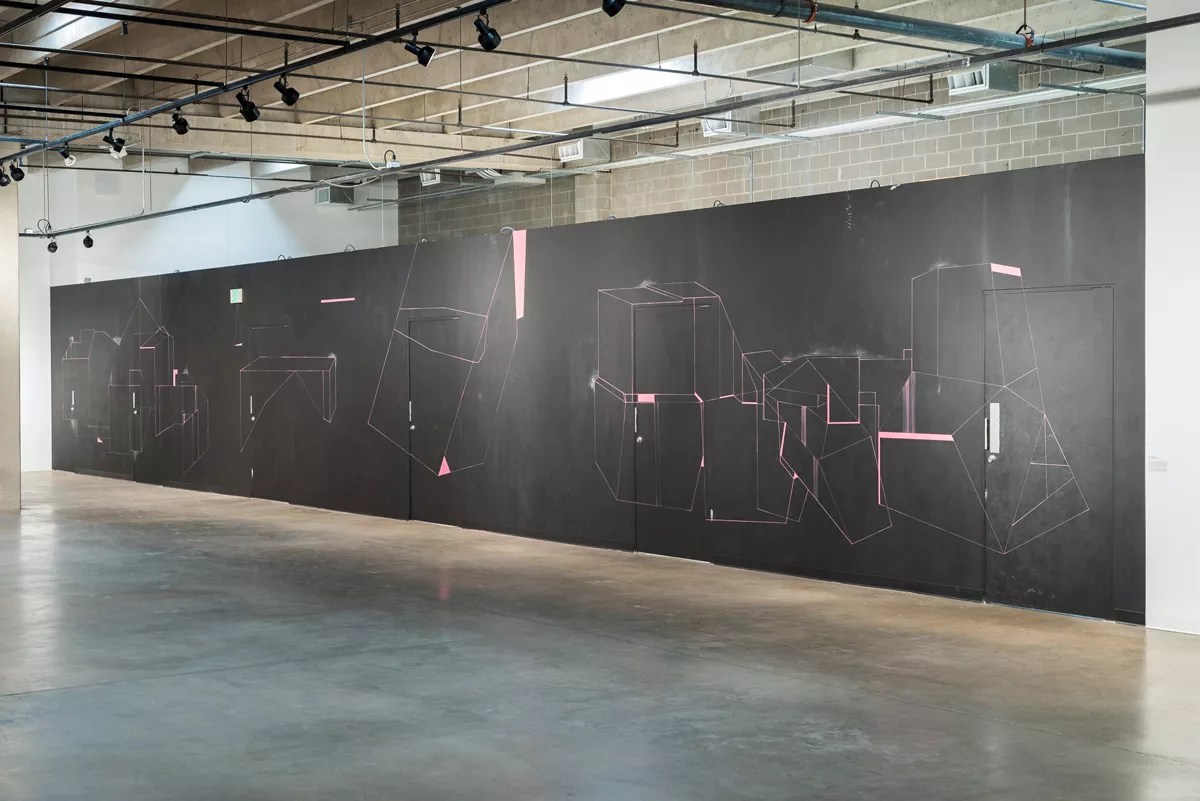
Downshifting gets off to a strong start with “Modo,” a wall mural by French artist Xavier Eltono, which wraps around the three sides of RedLine’s entry gallery. Although Eltono did not come to RedLine for the installation, he didn’t need to: Not unlike the late Sol LeWitt, Eltono creates generative formulas that determine the specific shapes, their relationships to one another, the colors to be used, and where each shade is to be placed. So once the prerequisites are determined, the work can be duplicated by others. That’s what happened here, with Whit Sibley, RedLine’s guy Friday, and others carrying out Eltono’s plans in paint. The mural is made up of a non-repeating pattern of odd shapes with hard edges done up in red, yellow and two shades of blue, all on a white ground.
The fabulous “Modo” is the perfect setup for an equally ambitious wall mural around the corner in the main space. “Higher Ground” is by hometown wall-mural whiz Sandra Fettingis. Denver is in the midst of a wall-mural craze that’s resulted in decidedly mixed results (tipping toward the bad, if you ask me). Fettingis is clearly among the best of the artists working in this field; she’s adorned innumerable exterior and interior walls around town with her signature geometric patterns. In the case of “Higher Ground,” which has a neo-deco quality, Fettingis has arranged black parallelograms and straight lines together with large circles and small half-circles in ketchup red and mustard yellow, with all of it set against lots of airy white ground. How summery!
Denver, make your New Year’s Resolution Count!
We’re $12,000 away from reaching our $50,000 year-end fundraising goal. Your support could be what pushes us over the top. If our work has kept you informed and connected this year, please consider making a contribution today.
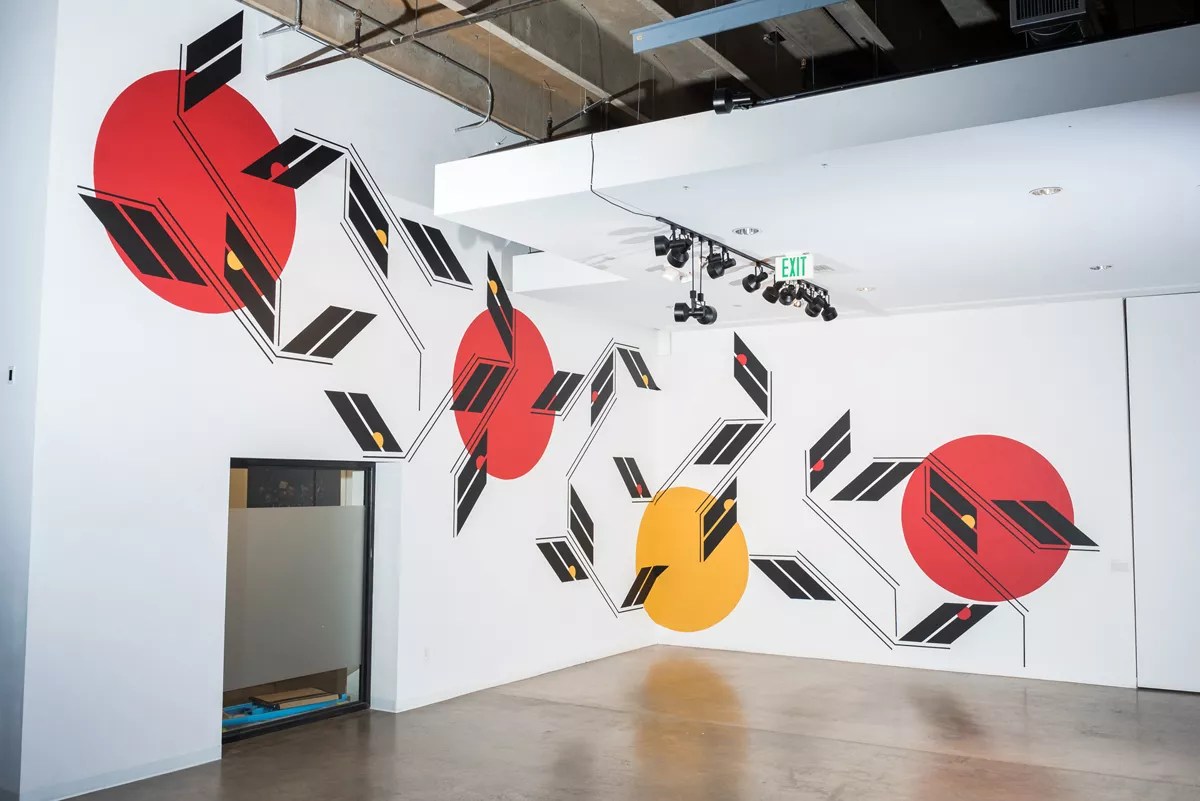
“Higher Ground.” by Sandra Fettingis, acrylic latex.
Coburn Huff
In the main gallery are three more wall murals, a 3-D installation and a bunch of smaller pieces that illustrate the different ways that artists are embracing reductive abstraction. Opposite the Fettingis is Ruth Campau’s “Seven Days,” a set of seven hanging Mylar sections that have been painted and crimped at the tops and bottoms; the silvery panels are designed to bring painting into the installation realm. Campau is one of several Danish artists in the show, her inclusion inspired (but not subsidized) by a grant from the Danish Embassy. On the wall across from the Campau works is a series of spare, linear compositions by Hyland Mather, who used to live in Denver but now resides in Amsterdam. From a distance, his pieces look like they are three-dimensional and made of metal rods, but when you get close, you see that they’re actually flat and created from string strung between strategically placed nails. “Meandering Paths Triumph over isms,” by Andrew Huffman, yarn, paint. Coburn Huff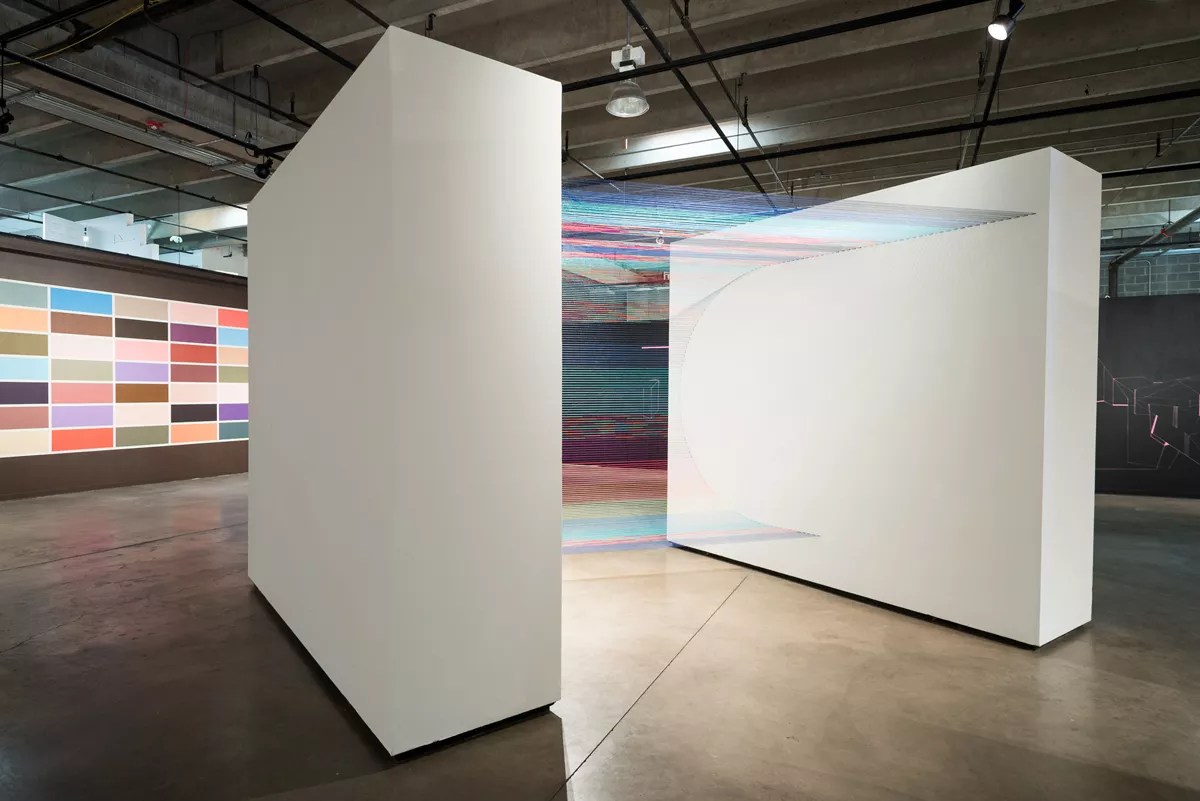
Occupying a huge footprint in the center of the space is Andrew Huffman’s “Meandering paths triumph over -isms,” a two-part installation whose halves are each in the shape of a circular scoop. Huffman has appropriated the gallery’s four movable walls and used them as anchors for evenly spaced courses of rainbow-painted yarn that’s stretched between them. Defining spaces with stretched yarn or string was first done by the late Fred Sandback in the ’60s and ’70s, but in the last few years, similar ideas have grown into a full-fledged international movement, and Huffman is its chief practitioner here in Colorado. On the west wall, where there are doors to some of RedLine’s studios, is Bonilla’s “Heliocentric Distance (CERCA)”; he’s painted the extremely long wall black with architectonic lines in a pinkish shade that look like perspective drawings of buildings. Although Bonilla wanted to use this wall in such a way that the piece would work whether or not the studio doors were closed, when they are open it definitely suffers.
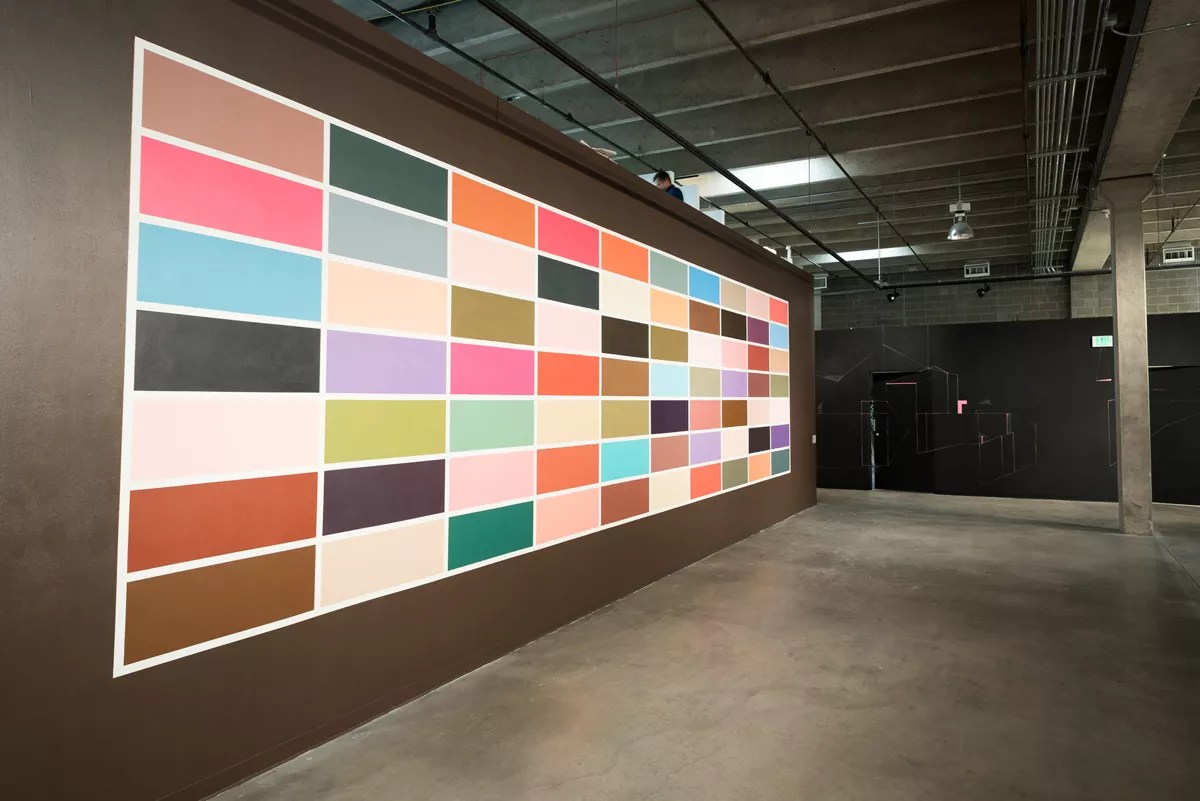
“Warpaint,” by Michael Mork, acrylic latex.
Coburn Huff
Across the back of the main space is another wall mural with a black ground, “Warpaint (Colorado version),” by Michael MÁ¸rk, whose participation in Downshifting was officially sponsored by the Danish Embassy. MÁ¸rk has created a grid pattern of horizontally oriented rectangles divided by white lines. Each of the rectangles has been filled in with flesh-tones and jewel-like shades inspired by makeup. Unlike most of the international artists, MÁ¸rk came to Denver to complete his piece. He had to change the specific colors he’d planned on, though, because he couldn’t precisely match the pigments he uses in Denmark, which is why he calls this one his “Colorado version.” Similar in subject to the better known work of Rachel Lachowicz but clearly different from a compositional standpoint, MÁ¸rk’s painting is serenely gorgeous, its modest composition offset by its luxurious palette. Coburn Huff
For the last of the great murals in this section of Downshifting, Frank T. Martinez, a Denver artist, has created “cede” with a composition descending from the ceiling and resolving itself close to the corner where two walls meet. He’s arranged colored shapes to give the illusion of three-dimensionality, but that suggestion falls apart as you examine the shapes close up, because their sides don’t really line up to make solids. Martinez’s sense for color is very strong, and this mural is the best thing I’ve seen by him.
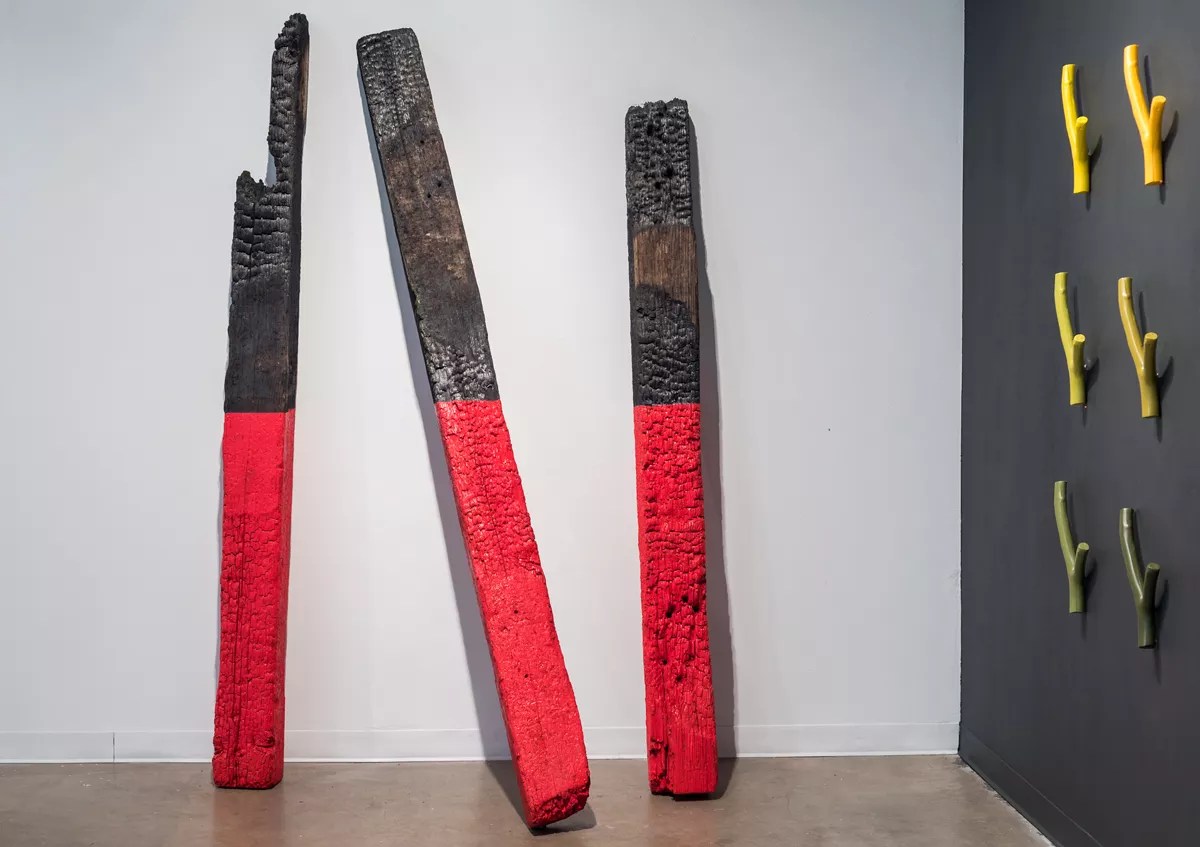
“Severance,” by Brian Napier, acrylic paint on wood.
Coburn Huff
Although Bonilla did not curate the companion exhibit in RedLine’s community gallery, Crooked Timber: Brian Napier works beautifully with Downshifting because it’s dominated by reductive art, even if there are also realistic paintings (which are very good). Napier is a young Colorado artist, and this show was organized by Odessa, an arts-advocacy group described as a “nomadic collective.”
The tour de force here is a wall of 100 cast gypsum elements in the shape of evenly spaced, conventionalized Y-shaped twigs. These twig-inspired elements have been colored in a spectrum of shades that gradually goes from hot tints on the left to cool ones on the right. The perfect counterpoint to this elegant wall is a grouping of three found timber beams off to the side that are scorched black at the top and painted fire-engine-red on the bottoms.
How to reduce art to its simplest expressions is something that occupies a lot of artists these days, and as these two exhibits show, less can often lead to more.
Downshifting through July 23, Crooked Timber through July 28, RedLine, 2350 Arapahoe Street, 303-296-4448, redlineart.org.